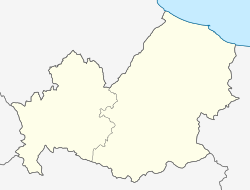
Monte Cassino is a rocky hill about 130 kilometres (80 mi) southeast of Rome, in the Latin Valley, Italy, 2 kilometres west of Cassino and at an elevation of 520 m (1,710 ft). Site of the Roman town of Casinum, it is best known for its abbey, the first house of the Benedictine Order, having been established by Benedict of Nursia himself around 529. It was for the community of Monte Cassino that the Rule of Saint Benedict was composed.
Sant'Angelo is an Italian name for the Archangel Michael.

Cassino is a comune in the province of Frosinone, Southern Italy, at the southern end of the region of Lazio, the last city of the Latin Valley.

The Province of Caserta is a province in the Campania region of southern Italy. Its capital is the city of Caserta, situated about 36 kilometres (22 mi) by road north of Naples. The province has an area of 2,651.35 square kilometres (1,023.69 sq mi), and a total population of 924,414 as of 2016. The Palace of Caserta is located near to the city, a former royal residence which was constructed for the Bourbon kings of Naples. It was the largest palace and one of the largest buildings erected in Europe during the 18th century. In 1997, the palace was designated a UNESCO World Heritage Site.

The province of Isernia is a province in the region of Molise in Italy. The provincial capital is the city Isernia and the president of the province is Alfredo Ricci. The province of Isernia has an area of 1,535.24 square kilometres (592.76 sq mi) and a population of 86,405 inhabitants as of 2016. It contains 52 comunes in the province, listed at comunes of the Province of Isernia.
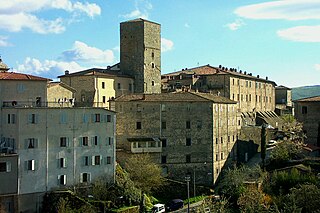
Santa Fiora is a comune (municipality) in the Province of Grosseto, in the Italian region of Tuscany, located about 110 kilometres southeast of Florence and about 40 km (25 mi) east of Grosseto. Santa Fiora borders the following municipalities: Abbadia San Salvatore, Arcidosso, Castel del Piano, Castell'Azzara, Piancastagnaio, Roccalbegna, Semproniano.
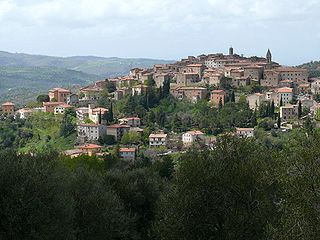
Seggiano is a comune (municipality) in the Province of Grosseto in the Italian region Tuscany, located about 100 kilometres (62 mi) south of Florence and about 40 kilometres (25 mi) northeast of Grosseto.

Cervaro is a town and comune (municipality) in the Province of Frosinone in the Italian region Lazio. It is located in the Liri valley, about 130 kilometres (81 mi) southeast of Rome and about 50 kilometres (31 mi) southeast of Frosinone.

Esperia is a comune (municipality) in the Province of Frosinone in the Italian region Lazio, located about 110 kilometres (68 mi) southeast of Rome and about 40 kilometres (25 mi) southeast of Frosinone. It is located within the Monti Aurunci Natural Park.

San Biagio Saracinisco is a comune (municipality) in the Province of Frosinone in the Italian region of Lazio, located about 120 kilometres (75 mi) east of Rome and about 50 kilometres (31 mi) east of Frosinone.

San Vittore del Lazio is a comune (municipality) in the Province of Frosinone in the Italian region Lazio, located about 130 kilometres (81 mi) southeast of Rome and about 50 kilometres (31 mi) southeast of Frosinone.

San Pietro Infine is a comune (municipality) in the Province of Caserta in the Italian region Campania, located about 70 kilometres (43 mi) northwest of Naples and about 50 kilometres (31 mi) northwest of Caserta. San Pietro Infine borders the following municipalities: Mignano Monte Lungo, San Vittore del Lazio, Venafro.
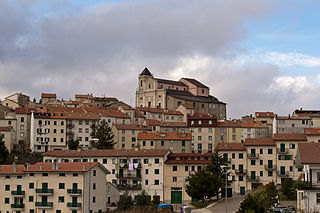
Capracotta is a comune (municipality) in the Province of Isernia in the Italian region of Molise, located about 45 kilometres (28 mi) northwest of Campobasso and about 25 kilometres (16 mi) north of Isernia.

Castel del Giudice is a comune (municipality) in the Province of Isernia in the Italian region of Molise, located about 50 kilometres (31 mi) northwest of Campobasso and about 30 kilometres (19 mi) north of Isernia.

Castel San Vincenzo is a comune (municipality) in the Province of Isernia in the Italian region Molise, located about 50 kilometres (31 mi) west of Campobasso and about 15 kilometres (9 mi) northwest of Isernia. The Abbey of San Vincenzo al Volturno is located in its territory. It is also home to an artificial lake, created in the 1950s for a hydroelectric plant.

Pesche is a comune (municipality) in the Province of Isernia in the Italian region Molise, located about 30 kilometres (19 mi) west of Campobasso and about 5 kilometres (3 mi) northeast of Isernia. As of 31 December 2004, it had a population of 1,459 and an area of 12.7 square kilometres (4.9 sq mi).
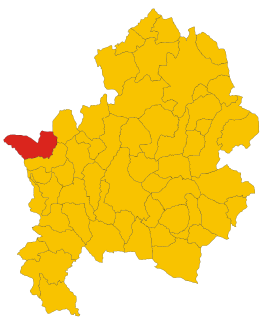
Pizzone is a comune (municipality) in the Province of Isernia in the Italian region Molise, about 50 kilometres (31 mi) west of Campobasso and about 20 kilometres (12 mi) northwest of Isernia near the Monti della Meta chain.

Vastogirardi is a comune (municipality) in the Province of Isernia in the Italian region Molise, located about 40 kilometres (25 mi) northwest of Campobasso and about 20 kilometres (12 mi) north of Isernia. As of 31 December 2004, it had a population of 789 and an area of 60.9 square kilometres (23.5 sq mi).
San Pietro is Italian for Saint Peter – see also Saint Peter (disambiguation).


